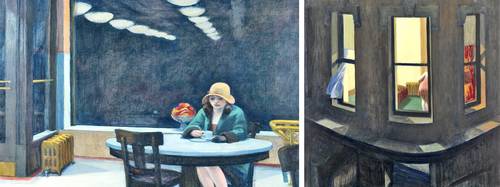The Whitney Museum in New York invites you to walk through the streets of this city that the painter Edward Hopper traveled for almost 60 years through an exhibition and an interactive map to explore from anywhere in the world and recognize the corners with which he portrayed the american life.
The Big Apple was the home of this artist for almost six decades, from 1908 until his death in 1967, a period that covered much of the maturity of his work and that coincided with a historical moment of development in this city.
Hopper was here (#HopperWasHere) It is the label to follow the steps on the island of Manhattan on social networks, in the places captured with its outline, such as rooftops, railways, stations and buildings. On the museum page there is access to the interactive map, and by selecting some of these points it is possible to see their paintings and how they look today.
For example, Washington Square, in the Greenwich Village neighborhood, seen from the window of his studio where he began working from 1913 until the end of his days. From there he saw life unfold, first as a freelance illustrator and then to become one of the world’s most celebrated artists.
During his lifetime, the New York city changed dramatically, with the rise of tall skyscrapers and exponential population growth.
with the title Edward Hopper’s New York the enclosure, located on the side of the Hudson River, opens the door to observe a selection of sketches, engravings, illustrations and paintings in which “he distilled his urban experience”, explains the Withney Museum. It is the great island that he wandered and observed with frequent walks around his neighborhood and during trips on the elevated rails of the train.
inspiration theme
The show, which concludes on March 5, is the first to “focus on the artist’s rich and sustained relationship with the city that persistently served as the theme, setting, and inspiration for many of his most famous and perplexing paintings.” ”.
The map presents just over 20 points to visit, including the Whitney Museum itself, located in the neighborhood once occupied by the slaughterhouses that supplied New Yorkers with meat, today converted into an area of galleries, and with the old train line transformed on a path with beautiful views for walkers.
Instead of laying his mark on the most famous places, Edward Hopper “turned his attention to little-known and even unknown places, small spaces off the beaten track; drawn to the uncomfortable clash of the old and the new, the civic and the residential, the public and the private that captured the paradoxes of a changing city.”
The windows through which he broke into private life have a special place in the exhibition, rooms that are some of his most representative works, as well as cafes and theater canopies.
“Hopper’s interiors suggest the vulnerability of private life in densely populated metropolises.”
The museum notes that “New York’s windowed facades served as dynamic structuring devices that he employed in compositions throughout his career.”


